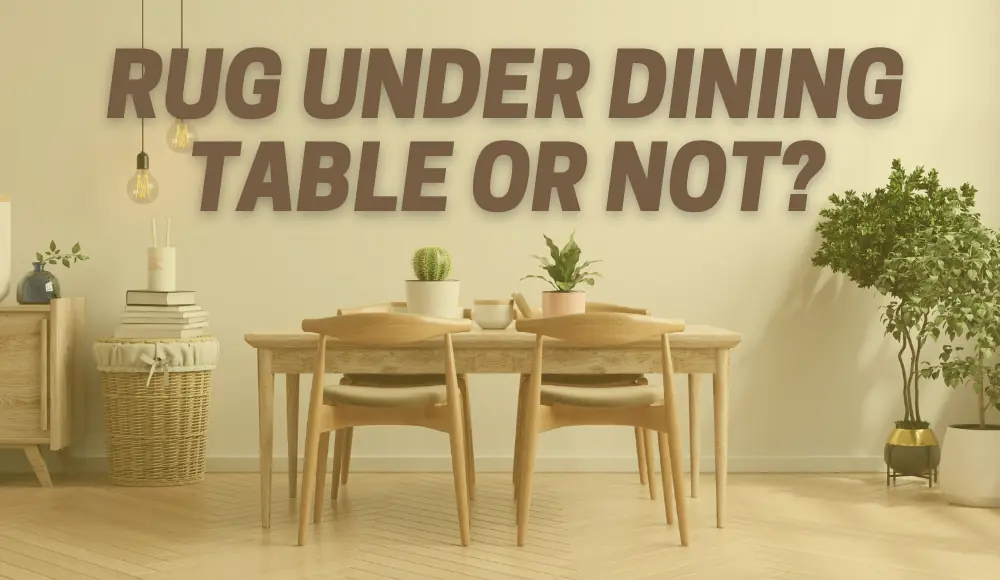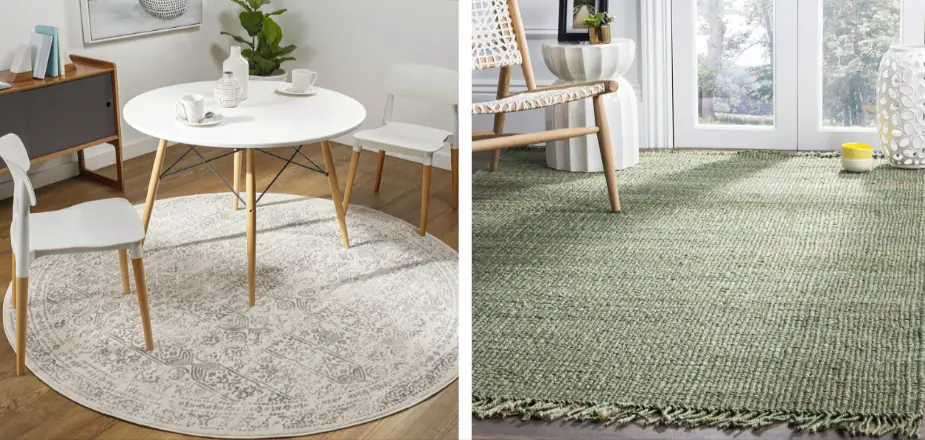When it comes to designing our dining rooms, we often find ourselves pondering over the question: Is it okay to not have a rug under your dining room table?
The choice may seem inconsequential, but it can greatly impact the overall aesthetic and functionality of the space.
In this article, we will explore the benefits and considerations of having a rug under your dining room table. So, if you’re curious about finding the perfect balance between style and practicality, read on!
Is it Okay to Not Have a Rug Under Your Dining Room Table?
So, let’s go straight from the main question.
Rug Under Dining Table or Not
Sure, it’s absolutely okay to not have a rug under your dining room table! Let me break it down for you in a conversational and engaging way.
Imagine this: you’re sitting at your dining room table, enjoying a delicious meal with your family or friends. The conversation is flowing, laughter fills the air, and everyone is having a great time.
Now, take a moment to look down. What do you see?
If you don’t have a rug under your dining table, that’s perfectly fine.
In fact, many people choose to leave their dining area rug-free, and here’s why:
- Easy maintenance: Picture this scenario: a glass of red wine accidentally tips over and spills onto the floor. Without a rug, you can quickly and easily clean up the mess without worrying about any long-term stains or damage. It’s hassle-free!
- Versatile style: By omitting a rug, you open up a world of possibilities for your dining room’s style. Maybe you have beautiful hardwood floors that you want to showcase or a unique tile pattern that adds character to the space. Without a rug, your flooring becomes the star of the show, allowing you to experiment with different furniture arrangements or decorative elements.
- Personal preference: Ultimately, it boils down to personal preference. Some people prefer the sleek, minimalist look of a rug-free dining area, while others enjoy the cozy and warm feeling that a rug can provide. It’s your space, so you get to decide what works best for you and your lifestyle.
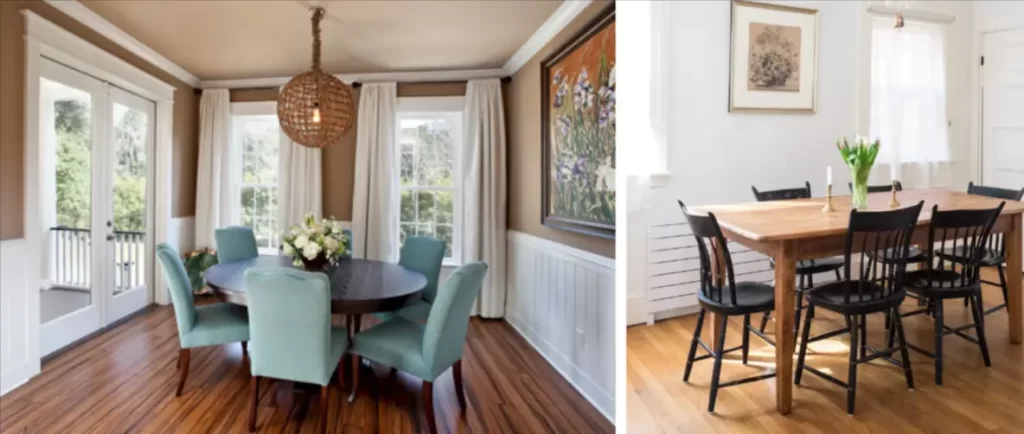
Remember, there are no hard and fast rules when it comes to decorating your home. It’s all about creating a space that reflects your personality and makes you feel comfortable.
So, if you love your dining room just the way it is, without a rug under the table, then that’s absolutely okay!
It’s always a good idea to consider your specific circumstances and preferences before making any decisions about your home decor.
Having or not having a rug under your dining room table is entirely up to you. Whether you choose to showcase your beautiful flooring or create a cozy atmosphere with a rug, the most important thing is to create a space that makes you and your loved ones feel at home.
Do We Need a Rug in the Dining Room?
Having a rug under your dining table is more than just a matter of preference. It serves multiple purposes, including enhancing the visual appeal of the room and providing practical benefits.
A rug adds warmth, texture, and depth to the dining area, making it visually pleasing. Moreover, it can help define the space and create a focal point, especially in an open-plan layout where the dining area merges with other zones like the living room.
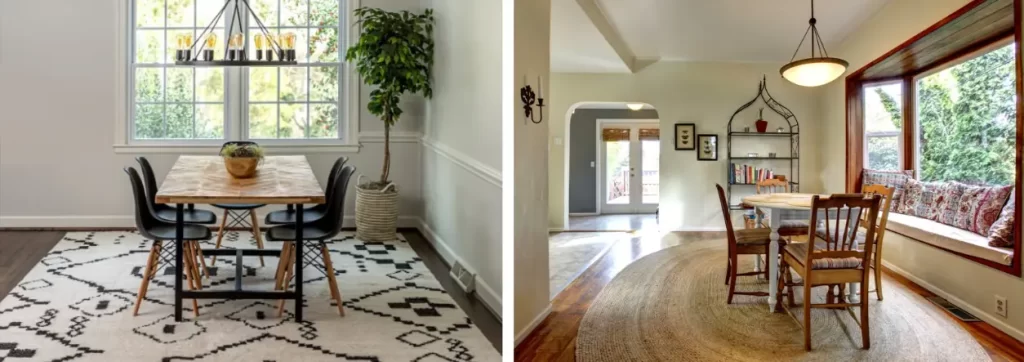
Beyond aesthetics, a rug also acts as a buffer between the table and the floor, protecting both surfaces.
It helps reduce noise caused by chairs being pulled in and out, minimizing the risk of scratching or damaging the flooring.
Additionally, it provides comfort underfoot, especially if your dining chairs don’t have cushions or are made of hard materials.
Does a Rug Have to Be Under Furniture?
No, a rug doesn’t have to be solely under furniture.
While it is common to place a rug under a dining table, it’s not the only option. Some people choose to have a rug that extends beyond the table, covering the entire dining area. This approach can create a unified look, particularly in open-concept spaces.
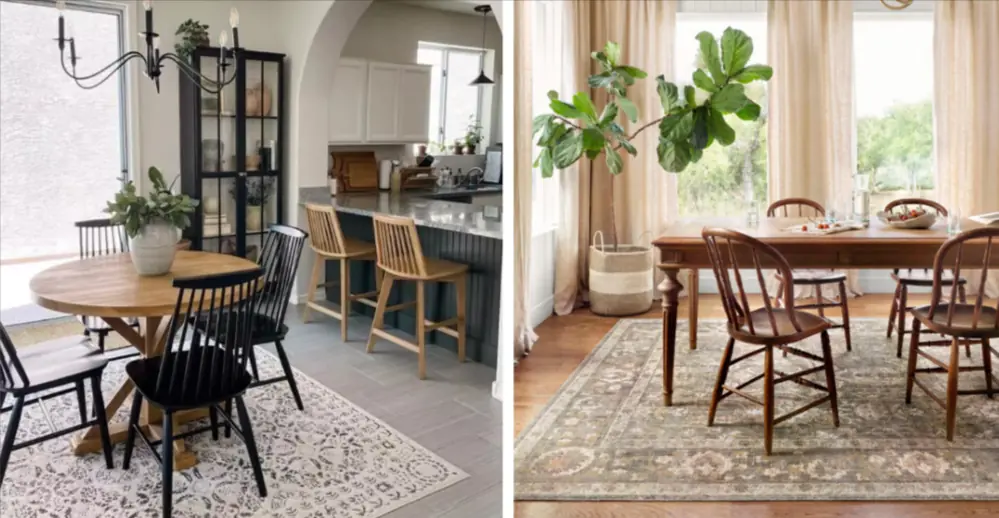
On the other hand, others prefer a smaller rug that fits snugly under the table, allowing the floor to be partially visible.
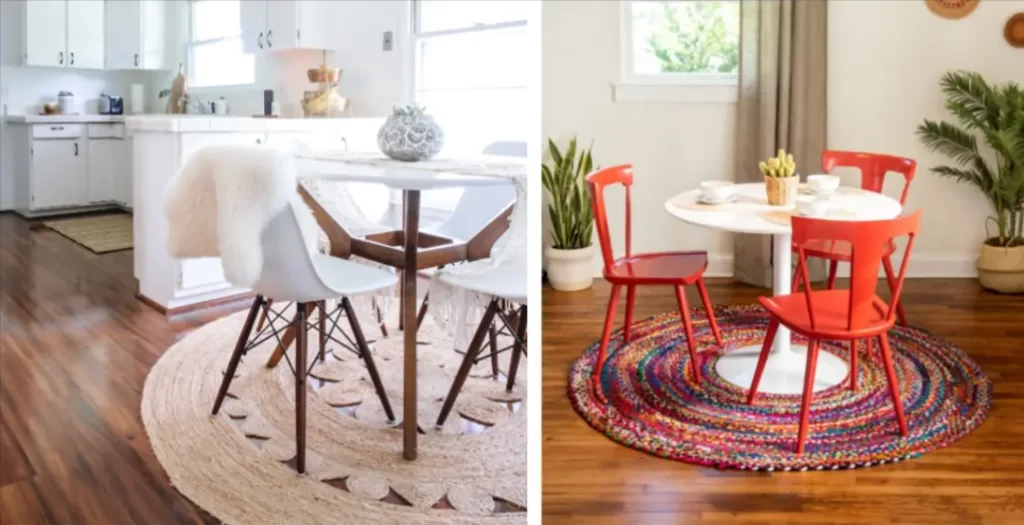
There are advantages to both approaches.
- A larger rug can make the dining area feel more cohesive and spacious. It visually connects the table and chairs, giving a sense of unity to the space.
- Conversely, a smaller rug can be a practical choice if you have limited space or an irregularly shaped dining table. It allows you to showcase the flooring while still enjoying the benefits of a rug.
Do People Have Carpets in the Dining Room?
Yes, many people choose to have carpets in their dining rooms.
It’s a design choice that has stood the test of time. While it may not be for everyone, those who opt for a carpet in the dining room often appreciate the aesthetic and functional advantages it brings.
Whether it’s a small rug under the table or a larger carpet that covers the entire dining area, the addition of a carpet can elevate the ambiance and create a more inviting space.
Why Do People Put Carpets in Dining Rooms?
The decision to place a carpet in the dining room stems from various factors.
Tradition, style, and functionality all play a role in this choice. In many cultures, having a carpet in the dining room is a longstanding tradition. It symbolizes warmth, hospitality, and elegance. Moreover, it helps create a distinct and separate area within the larger room, giving the dining space its own identity.
From a style perspective, a carpet can tie together the different design elements in the dining room.
It can complement the colors, patterns, and textures used in the room’s decor. By carefully selecting a rug that aligns with the overall theme, you can enhance the visual harmony and cohesiveness of the space.
On a functional level, a carpet in the dining room provides practical benefits. It helps protect the floor from spills, stains, and scratches, especially if you have young children or frequently entertain guests.
It also absorbs sound, reducing echoes and making conversations more pleasant. These functional advantages make a carpet a practical and attractive addition to the dining room.
What Should I Put Under My Dining Table?
The choice of what to put under your dining table depends on your personal style and the specific needs of your space.
Here are a few options to consider:
- Rug: As we’ve discussed, a rug is a popular choice for its visual appeal and practical benefits. It comes in various shapes, sizes, and materials, allowing you to find the perfect match for your dining room.
- Hardwood or Laminate Flooring: If you have beautiful hardwood or laminate flooring, you might want to showcase it by leaving the area under the table bare. This approach can create a clean and minimalist look, especially if the flooring is in excellent condition.
- Vinyl or Cork Tiles: Vinyl and cork tiles are durable, easy to clean, and provide a softer surface than hardwood. Placing them under your dining table can protect the floor while offering comfort and style.
- Carpet Tiles: For those who desire the warmth and comfort of the carpet but still want flexibility, carpet tiles are an excellent choice. They are easy to install, replace, and come in various designs to suit your taste.
Ultimately, the decision of what to put under your dining table should align with your overall design vision and lifestyle requirements.
Rule of Thumb for Rug Under the Dining Table
While there are no hard and fast rules, there are some guidelines to consider when choosing a rug for your dining table.
Here’s a rule of thumb to help you make an informed decision:
- Size: Ensure the rug is large enough to accommodate the dining chairs, even when they are pulled out. Ideally, there should be enough space for the chairs to remain on the rug, even when fully extended.
- Shape: The shape of the rug should mirror the shape of your dining table. If you have a rectangular table, opt for a rectangular rug. Similarly, a round table pairs well with a round or square rug.
- Material: Select a rug material that can withstand the demands of the dining area. Look for stain-resistant and easy-to-clean options, such as wool or synthetic blends. Avoid delicate or high-pile rugs that may trap food particles and require frequent maintenance.
- Pattern and Color: Consider the existing color palette and decor style of your dining room. Choose a rug that complements the overall theme while adding visual interest. Patterns can be a great way to hide spills and stains, making them an excellent choice for a dining area.
By following these guidelines, you can strike a balance between functionality and aesthetics, ensuring that your rug enhances both the look and usability of your dining room.
FAQs: Rug Under Dining Table or Not
Q: Is there an alternative to having a rug under the dining table?
A: Yes, if you prefer not to have a rug, you can explore alternatives such as vinyl or cork tiles, hardwood or laminate flooring, or even carpet tiles. These options provide practicality and style without the need for a traditional rug.
Q: Can I place a rug under my dining table if I have carpeted flooring?
A: Absolutely! Placing a rug under dining table on carpet can add an extra layer of visual interest and protection. It can help define the dining area and provide a contrasting texture against the carpet.
Q: How often should I clean a rug placed under my dining table?
A: Regular cleaning is essential to maintain the rug’s appearance and longevity. Vacuuming at least once a week and promptly addressing any spills or stains can help keep your rug looking fresh and clean. Depending on the material, you may also consider professional deep cleaning every 12 to 18 months.
Q: Can I use multiple rugs in my dining room?
A: Yes, using multiple rugs in a dining room can add dimension and visual interest. However, ensure that the rugs complement each other in terms of style, color, and size. They should work together to create a cohesive and harmonious look.
Q: How can I protect my rug from chair scratches?
A: To protect your rug from chair scratches, consider using furniture pads or glides. These attach to the bottom of the chair legs and provide a smooth surface that reduces friction and prevents damage to the rug fibers.
Q: Should the rug extend beyond the dining table?
A: The decision to have the rug extend beyond the dining table depends on your personal preference and the size of the room. A larger rug that encompasses the entire dining area can create a cohesive look, while a smaller rug that fits snugly under the table allows the floor to be partially visible.
In conclusion, having a rug under your dining table offers both aesthetic and practical benefits.
It can enhance the visual appeal of the space, protect the floor, reduce noise, and add comfort. Whether you choose a small rug that perfectly fits under the table or a larger carpet that encompasses the dining area, the key is to find a balance that suits your style and lifestyle.
So go ahead, explore the options, and transform your dining room into a cozy and inviting space with the perfect rug under your dining table.
Please note that the information provided in this article is for general guidance purposes only and does not substitute professional advice. Always consider your specific circumstances and consult with experts if needed.
